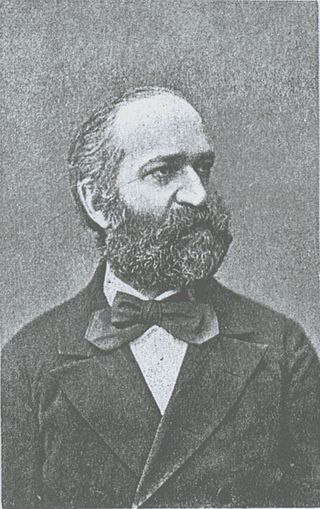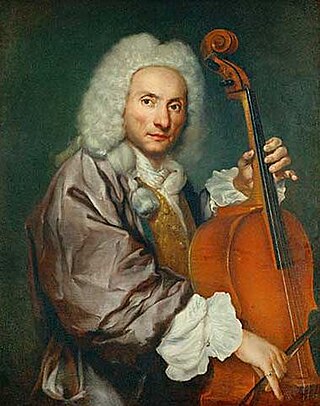Related Research Articles

The cello ( CHEL-oh), properly violoncello ( VY-ə-lən-CHEL-oh, Italian pronunciation: [vjolonˈtʃɛllo]), is a bowed (sometimes plucked and occasionally hit) string instrument of the violin family. Its four strings are usually tuned in perfect fifths: from low to high, C2, G2, D3 and A3. The viola's four strings are each an octave higher. Music for the cello is generally written in the bass clef, with tenor clef, and treble clef used for higher-range passages.

Chamber music is a form of classical music that is composed for a small group of instruments—traditionally a group that could fit in a palace chamber or a large room. Most broadly, it includes any art music that is performed by a small number of performers, with one performer to a part. However, by convention, it usually does not include solo instrument performances.
Francesco Zappa was an Italian cellist and composer who lived most of his adult life in The Hague, the Netherlands.

The Cello Sonata No. 3 in A major, Op. 69, is the third of five cello sonatas by Ludwig van Beethoven. He composed it in 1807–08, during his productive middle period. It was first performed in 1809 by cellist Nikolaus Kraft and pianist Dorothea von Ertmann, a student of Beethoven. Published by Breitkopf & Härtel the same year, it was dedicated to Freiherr Ignaz von Gleichenstein, Beethoven's friend and an amateur cellist. The sonata was successful with audiences from the beginning.

Ferdinand Thieriot was a German composer of Romantic music and a cellist.
Jean-Pierre Duport was a cellist of the late 18th and early 19th centuries. Along with his brother, Jean-Louis Duport, he was active in the musical life of France and Germany. Jean-Pierre was the son of a dancing master, and a student of the founder of the French school of cello playing Martin Berteau (1691–1771).

Giovanni Battista Cirri was an Italian cellist and composer in the 18th century.
Joel Krosnick is an American cellist who has performed as a soloist, recitalist, and chamber musician throughout the world for over 40 years. As a member of the Juilliard String Quartet from 1974 to 2016, he performed the great quartet literature throughout North America, Europe, Asia, and Australia.

Antonio Vandini, a close friend of Giuseppe Tartini, was a cellist and composer. He was one of the foremost virtuoso performers of his era and spent the vast majority of his career as the first violoncellist of the ″Veneranda Arca″ at the Basilica del Santo in Padua, where Tartini was first violinist and concertmaster. Upon the death of Tartini, he returned to Bologna, the city of his birth, where he died in 1778.
František Kočvara, known later in England as Frantisek Kotzwara, was a Czech violist, virtuoso double bassist and composer.

Johann Peter Pixis was a German pianist and composer, born in Mannheim. He lived in Vienna from 1808 to 1824, then in Paris to 1840, during which time he was among the city's most prominent pianists and composers, although he is almost entirely forgotten nowadays.
Johann Gottlieb Janitsch was a German Baroque composer who wrote in the galant style, transitional between the Baroque and Classical periods.
Jan Šťastný was a Czech composer and cellist from the end of the 18th century to the beginning of the 19th century. He is considered one of the founders of Czech national violoncello school.
Carlo Besozzi was an Italian oboist composer and member of an extensive family of oboists from the eighteenth-century Naples. Nephew of Gaetano Besozzi, he was employed in the orchestra of the Elector of Dresden and travelled extensively throughout Europe with his father, playing in London, Paris, Stuttgart and Salzburg, where he received good notices from Leopold Mozart.

Nathan "Tossy" Spivakovsky, a Jewish, Russian Empire-born, German-trained violin virtuoso, was considered one of the greatest violinists of the 20th century.

Robert Hausmann was a notable 19th-century German cellist who premiered important works by Johannes Brahms and Max Bruch. He was the cellist for the Joachim Quartet and taught at the Berlin Königliche Hochschule für Müsik.
The Studies for cello by Jean-Louis Duport (1749-1819), are a staple of cello pedagogical repertoire. Despite being over 200 years old, these études are still relevant to cellists today, although Duport's concert music is largely forgotten. Duport was a French cellist who, along with his brother Jean-Pierre Duport, revolutionized the performance of the cello. There previously had been few cello virtuosi, with a few notable exceptions such as Luigi Boccherini.
Domenico dall'Oglio was an Italian violinist and composer.
Markus Heinrich Grauel was a German composer and cellist of the classical period.
Salvatore Lanzetti was an Italian cellist and composer of the late Baroque and early Classical era.
References
- 1 2 Mara Parker, "Music for Public and Private Use: The Cello-Basso Sonatas of Carlo Graziani," Notes 68(3): 535-555.
- 1 2 3 4 5 Valerie Walden, revised by Mara Parker, "Graziani, Carlo," Grove Music Online https://doi.org/10.1093/gmo/9781561592630.article.11674.
- 1 2 Mara Parker, “‘Le plus Dous moment de ma vie’: Carlo Graziani and the Quest for Ideal Employment,” in: International Review of the Aesthetics and Sociology of Music 39(1): 31-56.